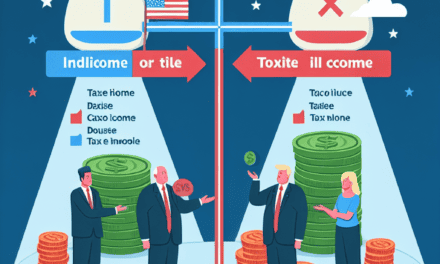“Market Soars: Trump Triumphs, Fed Focus Intensifies”
Introduction
In the wake of Donald Trump’s unexpected victory in the U.S. presidential election, global stock markets experienced a notable surge, reflecting investor optimism about potential economic policies under the new administration. The election outcome, which defied many pre-election forecasts, initially triggered volatility in financial markets. However, as investors digested the implications of Trump’s proposed tax cuts, deregulation, and infrastructure spending, confidence began to build, leading to a rally in equities. Concurrently, the Federal Reserve remained a focal point for investors, as speculation mounted regarding its monetary policy trajectory in response to the changing political landscape. The interplay between the anticipated fiscal stimulus from the Trump administration and the Fed’s interest rate decisions created a dynamic environment for market participants, underscoring the complex interdependencies between fiscal policy and central bank actions.
Impact Of Trump’s Election Victory On Global Stock Markets
The election of Donald Trump as President of the United States has had a profound impact on global stock markets, with investors around the world closely monitoring the implications of his victory. In the immediate aftermath of the election, stock markets experienced significant volatility, reflecting the uncertainty and anticipation surrounding the new administration’s policies. However, as the dust settled, a more optimistic sentiment began to emerge, leading to a notable rise in stock market indices across various regions.
One of the primary reasons for this upward trend is the market’s expectation of pro-business policies under Trump’s leadership. His campaign promises of tax cuts, deregulation, and increased infrastructure spending have been perceived as potential catalysts for economic growth. Investors are particularly hopeful about the proposed corporate tax reforms, which could enhance profitability for businesses and, in turn, boost stock prices. This optimism has been reflected in the performance of major stock indices, such as the Dow Jones Industrial Average and the S&P 500, which have reached record highs in the weeks following the election.
Moreover, Trump’s victory has also influenced global markets, with many international indices experiencing similar upward momentum. For instance, European markets have shown resilience, buoyed by the prospect of stronger economic ties with the United States. In Asia, markets have responded positively as well, although with some caution due to concerns about potential trade policy shifts. Nevertheless, the overall sentiment remains optimistic, as investors anticipate a more business-friendly environment that could spur global economic growth.
While the election outcome has undoubtedly played a significant role in shaping market dynamics, the Federal Reserve remains a critical factor in the equation. The central bank’s monetary policy decisions continue to be closely watched by investors, as they have the potential to influence market trends significantly. In the wake of Trump’s election, the Fed has maintained its cautious approach, signaling a gradual path towards interest rate normalization. This measured stance has provided a degree of stability to the markets, as investors weigh the potential impact of fiscal policy changes against the backdrop of monetary policy adjustments.
Furthermore, the interplay between fiscal and monetary policy is expected to be a key determinant of market performance in the coming months. As the Trump administration begins to implement its economic agenda, the Fed’s response will be crucial in maintaining a balance between fostering growth and preventing overheating. Investors are keenly aware of this dynamic, and any indications of policy shifts are likely to be met with swift market reactions.
In conclusion, the election of Donald Trump has ushered in a new era of market dynamics, characterized by both opportunities and challenges. The initial rise in stock markets reflects a sense of optimism about potential economic growth under the new administration. However, the role of the Federal Reserve remains pivotal, as its policy decisions will continue to shape investor sentiment and market trends. As the global economic landscape evolves, market participants will need to navigate these complexities with a keen eye on both fiscal and monetary developments. Ultimately, the interplay between these factors will determine the trajectory of global stock markets in the post-election era.
Federal Reserve’s Role In Post-Election Market Dynamics
The recent surge in the stock market following Donald Trump’s election victory has brought the Federal Reserve’s role into sharp focus, as investors and analysts alike seek to understand the dynamics at play. The intersection of political change and monetary policy is a critical area of interest, particularly as the Federal Reserve continues to wield significant influence over economic conditions. In the wake of the election, the market’s positive response can be attributed to a combination of factors, including anticipated fiscal policies and the central bank’s ongoing strategies.
To begin with, Trump’s election has generated expectations of substantial fiscal stimulus, including tax cuts and increased infrastructure spending. These potential policy shifts have fueled optimism among investors, who foresee accelerated economic growth and improved corporate earnings. Consequently, this optimism has translated into a bullish stock market, as market participants adjust their portfolios in anticipation of a more favorable business environment. However, while fiscal policy is a key driver, the Federal Reserve’s actions remain a crucial component of the broader economic landscape.
The Federal Reserve, under the leadership of its chair, continues to navigate a complex economic environment characterized by moderate growth and low inflation. In this context, the central bank’s decisions regarding interest rates and monetary policy are pivotal. The Fed’s dual mandate of promoting maximum employment and stabilizing prices necessitates a careful balancing act, particularly in light of potential fiscal expansion. As such, the Federal Reserve’s communication and policy decisions are closely monitored by market participants, who seek to gauge the likely trajectory of interest rates.
Moreover, the Federal Reserve’s role in maintaining financial stability cannot be overstated. In the post-election period, the central bank’s commitment to ensuring liquidity and managing systemic risks is of paramount importance. The Fed’s toolkit, which includes open market operations and regulatory oversight, is instrumental in fostering a stable financial environment. This stability, in turn, underpins investor confidence and supports the upward momentum in the stock market.
In addition to its domestic responsibilities, the Federal Reserve’s actions have global implications. As the world’s largest economy, the United States exerts considerable influence on international financial markets. Consequently, the Fed’s policy decisions reverberate beyond national borders, affecting exchange rates, capital flows, and global economic conditions. In this interconnected landscape, the central bank’s role in shaping expectations and managing market reactions is critical.
Furthermore, the Federal Reserve’s transparency and forward guidance play a vital role in shaping market dynamics. By clearly communicating its policy intentions and economic outlook, the Fed helps to anchor expectations and reduce uncertainty. This transparency is particularly important in the current environment, where political developments and economic indicators are closely intertwined. As investors navigate these complexities, the central bank’s guidance provides a valuable framework for decision-making.
In conclusion, the Federal Reserve’s role in post-election market dynamics is multifaceted and significant. While the stock market’s rise following Trump’s election victory is driven by a confluence of factors, the central bank’s influence remains a key consideration. Through its monetary policy decisions, commitment to financial stability, and global impact, the Federal Reserve continues to shape the economic landscape. As such, its actions and communications will remain in the spotlight, guiding market participants as they adapt to a changing environment.
Analyzing The Stock Market Surge Following Trump’s Win
The stock market has experienced a notable surge following the election victory of Donald Trump, a development that has captured the attention of investors and analysts alike. This upward trend in the market can be attributed to a confluence of factors, including investor optimism about potential economic policies under the Trump administration and the ongoing role of the Federal Reserve in shaping monetary policy. As the market reacts to these developments, it is essential to analyze the underlying reasons for this surge and consider the implications for future market behavior.
In the wake of Trump’s election win, investors have been buoyed by the prospect of pro-business policies that could stimulate economic growth. Trump’s campaign promises, such as tax cuts, deregulation, and infrastructure spending, have fueled expectations of increased corporate profitability and economic expansion. These anticipated policy changes have led to a rally in stock prices, particularly in sectors that stand to benefit from reduced regulatory burdens and increased government spending. For instance, financial stocks have seen significant gains, as investors anticipate a rollback of stringent regulations imposed after the 2008 financial crisis.
Moreover, the market’s positive response can also be attributed to the perception of a more business-friendly environment under Trump’s leadership. Investors are hopeful that the administration’s policies will create a more conducive climate for business operations, potentially leading to higher earnings and, consequently, higher stock valuations. This optimism has been reflected in the rising indices, with major stock market benchmarks reaching new highs in the days following the election.
While Trump’s victory has undoubtedly played a significant role in the market’s ascent, the Federal Reserve remains a critical factor in the broader economic landscape. The Fed’s monetary policy decisions continue to be closely monitored by investors, as they have far-reaching implications for interest rates and economic growth. In recent months, the Fed has signaled a cautious approach to raising interest rates, citing concerns about global economic conditions and domestic inflationary pressures. This dovish stance has provided additional support to the stock market, as low interest rates tend to encourage borrowing and investment, thereby boosting economic activity.
However, the interplay between the Trump administration’s policies and the Fed’s monetary strategy presents a complex dynamic that could influence market trends in the coming months. While the prospect of fiscal stimulus under Trump could lead to stronger economic growth, it may also prompt the Fed to adjust its policy stance to prevent overheating and control inflation. Such adjustments could include more aggressive interest rate hikes, which might temper the stock market’s upward momentum.
In conclusion, the stock market’s rise following Trump’s election victory is a multifaceted phenomenon driven by investor optimism about potential policy changes and the ongoing influence of the Federal Reserve. As the new administration takes shape and the Fed continues to navigate the economic landscape, market participants will be closely watching for signals that could impact future performance. While the current surge reflects positive sentiment, it is essential for investors to remain vigilant and consider the broader economic context as they make informed decisions in this evolving environment.
Investor Sentiment And Market Trends After The 2016 Election
The 2016 U.S. presidential election marked a significant turning point in the financial markets, as Donald Trump’s unexpected victory sent ripples through the global economy. Investor sentiment, which had been cautious in the lead-up to the election, shifted dramatically as markets began to digest the implications of a Trump presidency. The stock market, in particular, experienced a notable rise, reflecting a complex interplay of optimism and uncertainty. As investors recalibrated their expectations, the Federal Reserve also remained in the spotlight, with its monetary policy decisions closely scrutinized for potential impacts on market trends.
In the immediate aftermath of the election, the stock market’s response was characterized by a surge in major indices. The Dow Jones Industrial Average, for instance, reached record highs, buoyed by investor optimism about Trump’s pro-business agenda. His promises of tax cuts, deregulation, and infrastructure spending were perceived as catalysts for economic growth, prompting a rally in sectors such as financials, industrials, and materials. This initial enthusiasm, however, was tempered by concerns over potential trade policies and geopolitical uncertainties, which introduced a degree of volatility into the markets.
Transitioning from the election’s immediate impact, it is essential to consider the broader context of investor sentiment during this period. The market’s reaction was not solely driven by domestic factors; global economic conditions also played a crucial role. In particular, the Federal Reserve’s monetary policy decisions were a focal point for investors. With the U.S. economy showing signs of recovery, the Fed had signaled its intention to gradually raise interest rates. This prospect of tightening monetary policy added another layer of complexity to market dynamics, as investors weighed the implications of higher borrowing costs against the potential for economic expansion.
Moreover, the interplay between fiscal and monetary policy became a subject of intense debate among market participants. On one hand, Trump’s proposed fiscal stimulus measures were expected to boost economic growth, potentially leading to higher inflation. On the other hand, the Fed’s commitment to maintaining price stability suggested a cautious approach to interest rate hikes. This delicate balance between stimulating growth and controlling inflation created an environment of heightened uncertainty, prompting investors to closely monitor economic indicators and Fed communications.
As the months following the election unfolded, market trends began to reflect a more nuanced understanding of the new administration’s policies. While initial optimism had driven stock prices higher, investors became increasingly discerning, focusing on the feasibility and timing of proposed policy changes. This shift in sentiment was evident in the performance of different sectors, with some experiencing gains while others faced headwinds. For instance, the healthcare sector faced uncertainty due to potential changes in the Affordable Care Act, while technology companies navigated concerns over trade policies and regulatory scrutiny.
In conclusion, the 2016 election and its aftermath underscored the intricate relationship between political developments, investor sentiment, and market trends. The stock market’s rise in response to Trump’s victory highlighted the initial optimism surrounding his economic agenda, yet it also revealed the complexities of navigating an evolving policy landscape. As the Federal Reserve remained a key player in shaping market expectations, investors were reminded of the importance of balancing short-term reactions with long-term strategic considerations. This period served as a testament to the dynamic nature of financial markets, where political events and economic policies intersect to influence investor behavior and market outcomes.
The Federal Reserve’s Influence On Market Stability Post-Election
The recent presidential election, which saw Donald Trump emerge victorious, has had a significant impact on the stock market, with investors closely monitoring the Federal Reserve’s role in maintaining market stability. As the dust settles from the election, the stock market has experienced a notable rise, reflecting investor optimism about potential economic policies under the new administration. However, the Federal Reserve remains a critical player in this landscape, as its monetary policy decisions continue to influence market dynamics.
In the wake of the election, the stock market’s upward trajectory can be attributed to several factors. Investors are anticipating that the Trump administration will implement policies aimed at stimulating economic growth, such as tax cuts and deregulation. These potential changes have fueled a sense of optimism, leading to increased market activity and rising stock prices. Nevertheless, while the election outcome has provided a short-term boost to the market, the Federal Reserve’s actions will be crucial in determining the long-term stability of this upward trend.
The Federal Reserve, as the central bank of the United States, plays a pivotal role in shaping economic conditions through its control of interest rates and monetary policy. In the post-election period, the Fed’s decisions are under intense scrutiny, as investors seek to understand how it will navigate the challenges posed by the new administration’s economic agenda. The Fed’s primary mandate is to maintain price stability and achieve maximum employment, and its policy decisions are guided by these objectives. However, the potential for fiscal stimulus under the Trump administration could complicate the Fed’s task, as it may lead to inflationary pressures that require a recalibration of interest rates.
Moreover, the Federal Reserve’s influence extends beyond domestic markets, as its policies have global implications. In an interconnected world economy, changes in U.S. interest rates can affect capital flows, exchange rates, and economic conditions in other countries. Consequently, the Fed’s actions are closely watched by international investors and policymakers, who must adjust their strategies in response to shifts in U.S. monetary policy. This interconnectedness underscores the importance of clear communication from the Fed, as it seeks to manage market expectations and minimize volatility.
In addition to its monetary policy tools, the Federal Reserve also plays a role in ensuring financial stability through its regulatory oversight of the banking system. In the post-election environment, the Fed’s regulatory stance will be critical in maintaining confidence in the financial system, particularly if the new administration pursues significant changes to financial regulations. The Fed’s ability to balance its dual mandate of promoting economic growth while safeguarding financial stability will be tested as it navigates these complex challenges.
In conclusion, the stock market’s rise following Donald Trump’s election victory highlights the interplay between political developments and economic expectations. While investor optimism has driven recent market gains, the Federal Reserve’s role in maintaining stability remains paramount. As the central bank assesses the implications of the new administration’s policies, its decisions will be instrumental in shaping the future trajectory of the market. By carefully managing interest rates and maintaining clear communication, the Fed can help ensure that the current optimism translates into sustained economic growth and stability.
Sector Winners And Losers In The Stock Market After Trump’s Victory
The recent presidential election, which saw Donald Trump emerge victorious, has had a significant impact on the stock market, with various sectors experiencing notable shifts. As investors digest the implications of Trump’s policies, the Federal Reserve remains a focal point, influencing market dynamics. In the wake of the election, certain sectors have emerged as clear winners, while others face challenges, reflecting the complex interplay of political and economic factors.
One of the most prominent beneficiaries of Trump’s victory is the financial sector. The anticipation of deregulation, coupled with potential tax reforms, has fueled optimism among investors. Banks and financial institutions are expected to benefit from a more relaxed regulatory environment, which could enhance profitability. Additionally, the prospect of rising interest rates, as the Federal Reserve continues to signal a tightening monetary policy, further bolsters the sector. Higher rates typically lead to increased net interest margins for banks, making the financial sector an attractive investment option in the current climate.
Conversely, the healthcare sector presents a more nuanced picture. While pharmaceutical companies have experienced a boost, driven by expectations of reduced regulatory scrutiny, other areas within healthcare face uncertainty. Trump’s stance on the Affordable Care Act and potential reforms could disrupt the insurance market, creating volatility. Investors are closely monitoring policy developments, as any significant changes could have far-reaching implications for healthcare providers and insurers alike.
The industrial sector also stands to gain from Trump’s proposed infrastructure spending plans. The promise of increased investment in infrastructure projects has sparked enthusiasm among companies involved in construction, engineering, and materials. This anticipated boost in government spending is expected to drive demand for industrial goods and services, potentially leading to job creation and economic growth. However, the realization of these benefits hinges on the successful implementation of policy measures, which remains a subject of debate.
In contrast, the technology sector faces a more challenging landscape. Concerns over trade policies and potential restrictions on immigration have raised questions about the future of tech companies that rely heavily on global supply chains and a diverse workforce. While some tech giants may navigate these challenges successfully, smaller firms could encounter difficulties, impacting their growth prospects. The sector’s performance will largely depend on how trade negotiations unfold and whether companies can adapt to a changing regulatory environment.
Meanwhile, the energy sector is poised for transformation under Trump’s administration. The emphasis on energy independence and support for fossil fuels has buoyed traditional energy companies, particularly those involved in oil and gas production. However, this shift may come at the expense of renewable energy initiatives, which could face reduced government support. The long-term impact on the energy landscape will depend on the balance between fostering traditional energy sources and addressing environmental concerns.
As the stock market reacts to the election outcome, the Federal Reserve’s role remains crucial. The central bank’s decisions on interest rates and monetary policy will continue to influence market sentiment and sector performance. Investors are keenly aware of the Fed’s dual mandate of promoting maximum employment and stable prices, and any shifts in policy could have significant repercussions across various sectors.
In conclusion, Trump’s election victory has set the stage for a dynamic and evolving stock market landscape. While certain sectors stand to benefit from anticipated policy changes, others face challenges that require careful navigation. As the Federal Reserve remains in the spotlight, its actions will play a pivotal role in shaping the market’s trajectory. Investors must stay vigilant, assessing both political developments and economic indicators to make informed decisions in this complex environment.
Long-Term Market Implications Of Trump’s Presidency And Fed Policies
The recent surge in the stock market following Donald Trump’s election victory has captured the attention of investors and analysts alike, as they seek to understand the long-term implications of his presidency on the financial landscape. Trump’s pro-business stance, characterized by promises of tax cuts, deregulation, and infrastructure spending, has fueled optimism among market participants. This optimism is reflected in the rally that has seen major indices reach new heights. However, while the initial market reaction has been positive, it is crucial to consider the broader implications of Trump’s policies and the role of the Federal Reserve in shaping the economic environment.
To begin with, Trump’s proposed tax reforms aim to reduce the corporate tax rate, which could potentially increase corporate profits and, in turn, boost stock prices. By lowering the tax burden on businesses, the administration hopes to stimulate investment and economic growth. Additionally, Trump’s emphasis on deregulation, particularly in sectors such as energy and finance, is expected to create a more favorable business climate. This could lead to increased productivity and competitiveness, further supporting the upward trajectory of the stock market.
Nevertheless, it is important to recognize that these policies may also carry certain risks. For instance, significant tax cuts could lead to a substantial increase in the federal deficit, potentially resulting in higher interest rates as the government seeks to finance its debt. Higher interest rates could dampen economic growth and negatively impact stock valuations. Moreover, while deregulation may benefit certain industries, it could also lead to increased volatility and risk, particularly if regulatory oversight is insufficient to prevent financial misconduct or environmental harm.
In parallel with the developments in fiscal policy, the Federal Reserve remains a key player in determining the long-term direction of the market. The Fed’s monetary policy decisions, particularly regarding interest rates, have a profound impact on economic activity and investor sentiment. As the economy continues to recover from the disruptions caused by the COVID-19 pandemic, the Fed faces the challenge of balancing the need to support growth with the risk of inflation. Any indication of a shift towards a more hawkish stance could lead to market volatility, as investors adjust their expectations for future interest rate hikes.
Furthermore, the interplay between Trump’s policies and the Fed’s actions will be critical in shaping the economic landscape. For example, if fiscal stimulus leads to stronger-than-expected economic growth, the Fed may be compelled to raise interest rates more aggressively to prevent overheating. Conversely, if growth falters, the Fed may maintain a more accommodative stance to support the economy. This dynamic interaction underscores the importance of closely monitoring both fiscal and monetary policy developments to assess their combined impact on the market.
In conclusion, while the stock market’s initial response to Trump’s election victory has been positive, the long-term implications of his presidency and the Federal Reserve’s policies are complex and multifaceted. Investors must remain vigilant, considering both the potential benefits and risks associated with the administration’s economic agenda and the Fed’s monetary policy decisions. By doing so, they can better navigate the evolving financial landscape and make informed investment decisions that align with their long-term objectives.
Q&A
1. **Question:** How did the stock market react immediately after Trump’s election win in 2016?
– **Answer:** The stock market initially experienced volatility but then surged, with the Dow Jones Industrial Average reaching record highs shortly after Trump’s victory.
2. **Question:** What sectors saw significant gains following Trump’s election?
– **Answer:** Financials, industrials, and healthcare sectors saw significant gains due to expectations of deregulation, infrastructure spending, and changes to healthcare policies.
3. **Question:** Why was the Federal Reserve in the spotlight during this period?
– **Answer:** The Federal Reserve was in the spotlight due to expectations of interest rate hikes and how Trump’s economic policies might influence the Fed’s monetary policy decisions.
4. **Question:** What were investors’ expectations regarding Trump’s economic policies?
– **Answer:** Investors anticipated tax cuts, deregulation, and increased infrastructure spending, which were expected to boost economic growth and corporate profits.
5. **Question:** How did the bond market react to Trump’s election win?
– **Answer:** The bond market saw a sell-off, leading to rising yields, as investors anticipated higher inflation and increased government borrowing under Trump’s policies.
6. **Question:** What impact did Trump’s election have on the US dollar?
– **Answer:** The US dollar strengthened following Trump’s election, driven by expectations of stronger economic growth and higher interest rates.
7. **Question:** How did global markets respond to Trump’s victory?
– **Answer:** Global markets had mixed reactions, with some experiencing initial declines due to uncertainty, while others rebounded as investors adjusted to the potential impacts of Trump’s policies.
Conclusion
The stock market’s rise following Trump’s election victory can be attributed to investor optimism about potential pro-business policies, such as tax cuts and deregulation, which were anticipated to stimulate economic growth. Additionally, the Federal Reserve’s position in the spotlight suggests that monetary policy decisions were closely monitored by investors, as any changes in interest rates could significantly impact market dynamics. The combination of political and monetary factors created a complex environment where market participants weighed the potential benefits of a new administration against the uncertainties of future Fed actions. Overall, the market’s positive response reflected a cautious optimism about the economic outlook under the new leadership.





